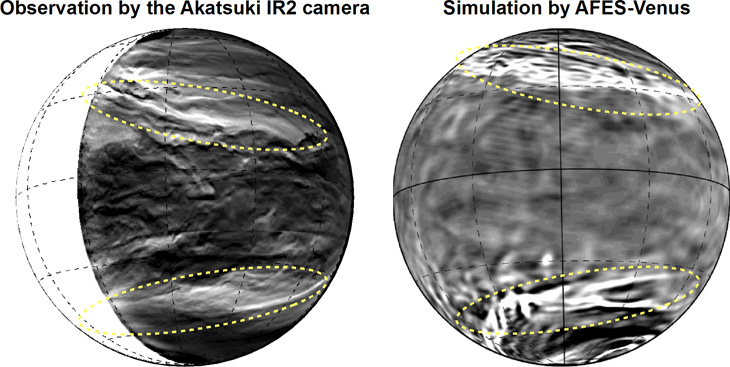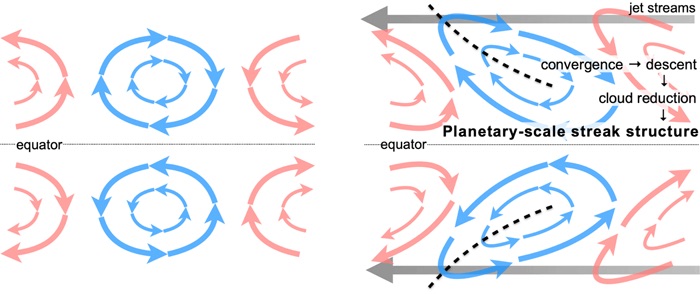Bizarre Symmetrical Streaks Spied in Atmosphere of Venus

Surprise! New pictures show two symmetrical streaks hiding in the sulfuric acid clouds close to the surface of Venus.
The Japanese Akatsuki spacecraft spotted the twin phenomena in Venus' northern and southern hemispheres. Each streak is roughly 6,200 miles (10,000 kilometers) across. That's more than double the distance between San Francisco and New York City.
Venus is close to Earth's size but orbits closer to the sun than our home does. Venus isn't habitable by life as we know it, not by any stretch of the imagination. Its atmosphere is mostly carbon dioxide. It has clouds made of sulfuric acid. The planet is, in fact, fully enveloped in clouds, and you cannot see its surface with the naked eye. Underneath the clouds lies a world shaped by the runaway greenhouse effect and featuring oven-like temperatures, possible active volcanoes and bone-crushing pressures.
This is all old news to researchers — after all, Soviet Union landers briefly survived this surface environment in the 1970s and 1980s — but the streaks were previously unknown. And they may be unique to Venus.
The story of their formation isn't too alien, though: The streaks are related to polar jet streams, researchers from Japan's Kobe University, which led the study, said in a statement. Polar jet streams are found on Earth, but their results are different on Venus.
At Earth's mid and high latitudes, dynamic winds can form cyclones, high-pressure systems and jet streams — and the same thing is probably happening at the high latitude of Venus, the university's analysis shows. But at lower latitudes on Venus, things get a little weird. Large-scale flows in the Venus atmosphere, coupled with that world's planetary rotation, create huge vortexes starting at the equator and stretching as far as 60 degrees latitude north and south. On Earth, the equivalent vortex would stretch well into Canada in the north — and as far south as the ocean near Antarctica.

"When jet streams are added to this phenomenon, the vortexes tilt and stretch, and the convergence zone between the north and south winds forms as a streak," researchers said in the statement. "The north-south wind that is pushed out by the convergence zone becomes a strong downward flow, resulting in the planetary-scale streak structure." Planetary rotation and atmospheric fluctuations over the equator keep the hemispheres symmetrical.
Get the Space.com Newsletter
Breaking space news, the latest updates on rocket launches, skywatching events and more!
Akatsuki captured the streaks using an infrared camera that can measure wavelengths of 2 micrometers (a tiny fraction of a millimeter). This allows the spacecraft to spy on the construction of lower cloud banks only 31 miles (50 km) from the surface. Researchers modeled the atmosphere using a program called AFES-Venus, developed before Akatsuki arrived at Venus in 2015. (The probe was supposed to get there in 2010 but missed the opportunity; the second attempt worked.)
The researchers noted that it is difficult to observe Venus' surface and lower atmosphere, which could affect the accuracy of the simulations.
A study based on the research was published Jan. 9 in the journal Nature Communications. The research was led by Hiroki Kashimura, a project assistant professor at Kobe.
Follow us on Twitter @Spacedotcom and on Facebook.
Join our Space Forums to keep talking space on the latest missions, night sky and more! And if you have a news tip, correction or comment, let us know at: community@space.com.

Elizabeth Howell (she/her), Ph.D., was a staff writer in the spaceflight channel between 2022 and 2024 specializing in Canadian space news. She was contributing writer for Space.com for 10 years from 2012 to 2024. Elizabeth's reporting includes multiple exclusives with the White House, leading world coverage about a lost-and-found space tomato on the International Space Station, witnessing five human spaceflight launches on two continents, flying parabolic, working inside a spacesuit, and participating in a simulated Mars mission. Her latest book, "Why Am I Taller?" (ECW Press, 2022) is co-written with astronaut Dave Williams.









